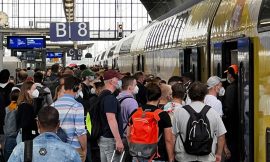The two pools of the Olympic aquatic center will be reused in Sevran and Bagnolet, and 15 new pools will be installed thanks to the Olympic Games legacy program.
The Seine-Saint-Denis, the central site of the Olympics with the Stade de France and the Olympic Village, could be the winning department of the event. It will take a few years to assess and evaluate the promises kept. But in terms of aquatic sports, the legacy already looks very positive.
“60% of 6th graders cannot swim”
Between new constructions, renovations, and reuse, 18 new pools are planned in this historically under-equipped region in terms of aquatic facilities. As Mélanie Morgeau, director of the JOP 2024 delegation at the Departmental Council of Seine-Saint-Denis, points out: “We have 60m² of pool for every 10,000 inhabitants in the department, compared to 160m² at the regional level and 260m² at the national level. And about 60% of young people starting 6th grade do not know how to swim…”
The Olympic swimming and water polo competitions will take place at the rugby stadium La-Défense Arena. In May, two 50-meter pools will be installed there and will be dismantled after the event to be transferred to municipalities in the department. Sevran will benefit from the main 50m pool, while Bagnolet will receive half of the warm-up pool, equivalent to a 25m pool. Moving floors are planned to facilitate future adjustments in pool depth.
In addition, a pool will be renovated in Montreuil, and 15 new pools will be created in Saint-Denis (3), Aubervilliers (2), La Courneuve (5), and Aulnay-sous-Bois (5).
In Sevran, the capacity to accommodate students will triple.
“We had an obsolete pool. This one will consume 13% less thanks to solar energy and will triple the capacity for students and clubs,” said Clémentine Lerévérend, director of cabinet at Sevran. For example, the cost of 26 million euros will be funded 70% by the Solideo legacy program, the public establishment in charge of Olympic infrastructure, along with the Greater Paris Metropolitan Area, the Departmental Council, the State, and the National Sports Agency. Its delivery is scheduled for autumn 2025.
Marion Le Paul, deputy general manager of Solideo, emphasizes “strong ambitions in terms of ecology and accessibility for people with disabilities.” The Aulnay pool will be equipped with audio beacons and a room for guide dogs. The heat from wastewater will be recycled for site heating.
“The Games are a significant accelerator”
“We launched a departmental pool plan in 2016 with 40 million euros over 5 years, but it was not enough to fill the gap. The Games are a significant accelerator in this regard,” rejoices Mélanie Margeau.
For Quentin Gesell, vice-president in charge of sports at the Greater Paris Metropolitan Area, this is an opportunity to carry out a “territorial rebalancing with 18.5 million from the metropolitan heritage plan.” The official highlights “26 new lanes in the heart of Saint-Denis neighborhoods that will also evolve after the Games.”
“1,2,3 swim!” program in disadvantaged neighborhoods
Meanwhile, the French Swimming Federation continues its “1,2,3 swim!” program deployed in disadvantaged neighborhoods for children aged 4-12. Thanks to the establishment of temporary pools and the supervision of FFN educators, especially during holidays, 26,000 children have already benefited from it, including 9,500 in Seine-Saint-Denis. The goal is to intensify the program to train 100,000 new young people by the Olympics with the support of EDF, a partner of the operation. And if its sponsor, Florent Manaudou, steps back onto the podium, there is no doubt that he will inspire many others.



